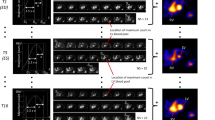Abstract
Background
Gated blood pool single photon emission computed tomography (SPECT) (GBPS) uses truly 3-dimensional (3D) data, requiring attention to appropriate reference systems and segmentation models for proper quantification. To date, optimal 3D reference models have not been evaluated. In this study several techniques for 3D GBPS were evaluated.
Methods and Results
Static and dynamic cardiac phantom evaluations were performed, and GBPS studies for 3 healthy subjects and 9 patients were processed by a variety of 3D analysis techniques to determine the optimum parameters for identification of abnormal segments when compared with coronary arteriography and left ventriculography. Left ventricular wall motion was quantified by calculation of regional ejection fraction (rEF) through use of count, volume, and cord length changes from end diastole to end systole. Three contractile models were evaluated: (1) fixed center of mass (COM), (2) floating COM, and (3) a modification of the method developed by Slager et al (J Am Coll Cardiol 1986;7:317-26), based on the motion of implanted endocardial markers. Eight, twelve, and eighteen 3D segments were analyzed by means of the 3 contractile models and correlated against coronary artery disease assessed by coronary arteriography. Single-head gamma-camera acquisition provided adequate counting statistics to reliably compute rEF for up to 18 left ventricular segments. Using count changes the overall results were able to identify myocardium supplied by diseased coronary arteries when compared with coronary arteriography. Cord length and, to a lesser degree, volume changes provided somewhat poorer sensitivities and specificities when compared with rEF computed from regional count changes, as compared with coronary arteriography.
Conclusions
Three-dimensional quantitative GBPS appears to be a sensitive method for assessing wall motion defects due to coronary artery disease.
Similar content being viewed by others
References
Strauss HW, Zaret BL, Hurley PJ, et al. A scintiphotographic method for measuring left ventricular ejection fraction in man without cardiac catherization. Am J Cardiol 1971;28:575–80.
Bacharach SL, Green MV, Borer JS. Instrumentation and data processing in cardiovascular nuclear medicine: evaluation of ventricular function. Sem Nucl Med 1979;9:257–74.
Bonow RO, Bacharach SL, Green MV, et al. Impaired left ventricular diastolic filling in patients with coronary artery disease: assessment with radionuclide angiography. Circulation 1981;64:315–23.
Bonaduce D, Morgano G, Petretta M, et al. Diastolic function in acute myocardial infarction. a radionuclide study. J Nucl Med 1988;29:1786–9.
Moore ML, Murphy PH, Burdine JA. ECG gated emission computed tomographs of the cardiac blood pools. Radiology 1980;134:233–5.
Corbett JR, Jansen DE, Lewis SE, et al. Tomographic gated blood pool radionuclide ventriculography analysis of wall motion and left ventricular volumes in patients with coronary artery disease. J Am Coll Cardiol 1985;6:349–58.
Gill JB, Moore RH, Tamaki N, et al. Multigated blood-pool tomography. new method for the assessment of left ventricular function. J Nucl Med 1986;27:1916–24.
Fischman AJ, Moore RH, Gill JB, et al. Gated blood pool tomography: a technology whose time has come. Semin Nucl Med 1989;19:13–21.
Groch MW, Schippers DJ, Marshall RC, et al. A quantitative program for gated blood pool SPECT imaging. Clin Nucl Med 1991;16:71.
Groch MW, Marshall RC, Erwin WD, et al. Quantitative gated blood pool SPECT imaging: enhanced sensitivity for non-invasive assessment of coronary artery disease. J Nucl Med 1993;34:35P.
Groch MW, Marshall RC, Erwin WD, et al. Quantitative gated blood pool SPECT for the assessment of coronary artery disease at rest. J Nucl Cardiol 1998;5:567–73.
Groch MW, Marshall RC, Erwin WD, et al. Quantitative gated blood pool SPECT imaging: sensitivity dependence on region definition. J Nucl Med 1996;37:6.
Faber TL, Stokely EM, Templeton GH, et al. Quantification of three-dimensional left ventricular segmental wall motion and volumes from gated tomographic radionuclide ventriculograms. J Nucl Med 1989;30:638–49.
Schippers DJ, Groch MW, Marshall RC, et al. Three dimensional analysis of gated blood pool SPECT. J Nucl Med 1995;36:12P.
Vilain D, Dauo D, Casset-Senon D, et al. Optimal 3-dimensional method for right and left ventricular Fourier phase analysis in electrocardiography-gated blood pool SPECT. J Nucl Cardiol 2001;8:371–8.
Budinger TF, Gullberg G, Huesman RH. Emission computed tomography. In: Herman GT, ed. Image reconstruction from projections. New York: Springer-Verlag; 1979. p. 171–80.
Jaszczak RJ, Coleman RE, Whitehead FR. Physical factors affecting quantitative measurements using camera-based single photon emission computed tomography (SPECT). IEEE Trans Nucl Sci 1981;28:69–80.
King MA, Long DT, Brill AR. SPECT volume quantitation. influence of spatial resolution, source size and shape and voxel size. Med Phys 1991;18:1016–24.
Anema PC, Verweij A, Reijs AE, et al. Accuracy of contour detection of small objects in scintigraphic images [abstract]. J Nucl Med 1989;30:806.
Slager CJ, Hooghoudt TE, Serruys PW, et al. Quantitative assessment of regional left ventricular motion using endocardial landmarks. J Am Coll Cardiol 1986;7:317–26.
Ishida I, Kimura K, Tani A, et al. Radial long-axis tomography for simultaneous assessment of regional myocardial perfusion with Tl-201 and LV wall motion with Tc-99m-RBC gated blood pool SPECT [abstract]. J Nucl Med 1990;31:808.
Shott S. Statistics for health professionals. Saunders: Philadelphia; 1990.
Cerqueira MD, Harp GD, Ritchie JL. Quantitative gated blood pool tomographic assessment of regional ejection fraction: definition of normal limits. J Am Coll Cardiol 1992;20:934–41.
Caputo GR, Graham MM. Measurement of left ventricular volume using emission computed tomography. In: Esser PD, editor. Emission computed tomography. New York: Society of Nuclear Medicine;1983. p. 147–53.
Bunker SR, Hartshorne MF, Schmidt WP, et al. Left ventricular volume determination from single-photon emission computed tomography. AJR Am J Roentgenol 1985;144:295–8.
Author information
Authors and Affiliations
Corresponding author
Rights and permissions
About this article
Cite this article
Groch, M.W., Schippers, D.J., Marshall, R.C. et al. Quantitative gated blood pool SPECT: Analysis of 3-dimensional models for the assessment of regional myocardial wall motion. J Nucl Cardiol 9, 271–284 (2002). https://doi.org/10.1067/mnc.2002.121448
Issue Date:
DOI: https://doi.org/10.1067/mnc.2002.121448




